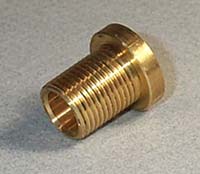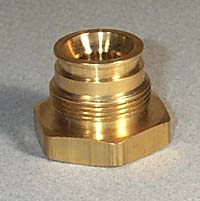HVAC HEATING ELEMENT HOUSING
| APPLICATION | HVAC |
| SPECIAL FEATURES | Costly Deep-Hole Drilling |
| PART WEIGHT | 0.039 pounds (Brass) |
| BRASS RAW MATERIAL PREMIUM | 40% (Including Turnings Allowance) |
| CYCLETIME (C360 BRASS) | 3.7 sec (781 pieces/hr @ 80% Efficiency) |
| CYCLETIME (12L14 STEEL) | 8.3 sec (304 pieces/hr @ 70% Efficiency) |
| PRODUCTIVITY GAIN USING BRASS | 157% |
| NET COST SAVINGS (BRASS VS. BARE STEEL) |
22%, $35.17 per 1000 |
| NET COST SAVINGS (BRASS VS.PLATED STEEL)* | 26%, $43.90 per 1000 |
LEADED STEEL PART NOW FREE-CUTTING BRASS
 This housing for an HVAC heating element is a precision product that must be strong and corrosion resistant. Now made from Free-Cutting Brass, Copper Alloy 360 (UNS C36000), the fitting takes less than four seconds to machine on an Acme-Gridley RA6. Its relatively deep hole and outside threads could make the part difficult and expensive to produce. In fact when this fitting was formerly made from 12L14 leaded steel it took more than twice as long to machine and cost 22% more than it now does in brass.
This housing for an HVAC heating element is a precision product that must be strong and corrosion resistant. Now made from Free-Cutting Brass, Copper Alloy 360 (UNS C36000), the fitting takes less than four seconds to machine on an Acme-Gridley RA6. Its relatively deep hole and outside threads could make the part difficult and expensive to produce. In fact when this fitting was formerly made from 12L14 leaded steel it took more than twice as long to machine and cost 22% more than it now does in brass.
Automatic screw machine parts often cost less in brass than steel. Why? One reason is that typical screw machine parts require a lot of machining-for this HVAC housing, about 66% of the starting stock ends up as turnings. These brass turnings have a high recycle value, which is always credited against the raw material cost, by the screw machine house. But the main reason brass parts cost less is that Free-Cutting Brass machines so much faster than leaded steel; the better machinability of brass resulted in a 157% productivity gain for the fitting shown above. Remember, when you're buying screw machine parts you're really paying for machine time. The faster the cut, the lower the cost.
BRASS IS AS STRONG AS STEEL
Many designers don't realize that the strength of half-hard Free-Cutting Brass and cold-reduced 12L14 leaded steel (the most common conditions for screw machine parts) overlap the same range. Here are the published nominal values:
| MATERIAL | TENSILE PROPERTIES | |
|---|---|---|
| YIELD STRENGTH | ULTIMATE STRENGTH | |
| C36000 | 45 ksi | 58 ksi |
| Hot Rolled 12L14 | 34 ksi | 57 ksi |
| Cold Drawn 12L14 | 60 ksi | 78 ksi |
That means that for almost one-half of all screw machine products, brass can be substituted for leaded steel without any sacrifice in strength or safety.
ELIMINATE PLATING COSTS
Ordinary zinc/chromate plating typically adds between 11 and 16 cents per pound to the cost of steel screw machine products. And it's difficult to insure uniformity when plating threads, sharp corners or deep holes. Now that this housing is made from Free-Cutting Brass, it doesn't have to be plated. Brass's natural corrosion resistance uniformly protects the entire surface.
HYDRAULIC FITTING
| APPLICATION | Off Highway/Construction |
| SPECIAL FEATURES | Finish, internal threads |
| PART WEIGHT | 0.091 lb. (Brass) |
| BRASS RAW MATERIAL PREMIUM | 36% (Including Turnings Allowance) |
| CYCLE TIME (C360 BRASS) | 5.6 sec (515 pieces per hour @ 80% Efficiency) |
| CYCLE TIME (LEADED STEEL) | 9.1 sec (277 pieces per hour @ 70% Efficiency) |
| PRODUCTIVITY GAIN USING BRASS | 86% |
| NET COST SAVINGS (BRASS VS. BARE STEEL) | 19% = $46.00 per 1000 |
| NET COST SAVINGS (BRASS VS.PLATED STEEL)* | 23% = $59.47 per 1000 |
STRENGTH PLUS CORROSION RESISTANCE EQUALS SAFETY
 This hydraulic fitting for heavy duty construction equipment, a typical screw machine part, has to be strong and corrosion resistant to meet OEM performance and safety requirements. Originally made from 12L14 leaded steel, the fitting is now produced in Free-Cutting Brass, Copper Alloy 360 (UNS C36000). It's just as strong as steel, it doesn't have to be plated and it costs 23% less. The strength of half-hard Free-Cutting Brass is in the same range as 12L14 steel. Published nominal values for these materials are:
This hydraulic fitting for heavy duty construction equipment, a typical screw machine part, has to be strong and corrosion resistant to meet OEM performance and safety requirements. Originally made from 12L14 leaded steel, the fitting is now produced in Free-Cutting Brass, Copper Alloy 360 (UNS C36000). It's just as strong as steel, it doesn't have to be plated and it costs 23% less. The strength of half-hard Free-Cutting Brass is in the same range as 12L14 steel. Published nominal values for these materials are:
| MATERIAL | TENSILE PROPERTIES | |
|---|---|---|
| YIELD STRENGTH | ULTIMATE STRENGTH | |
| C36000 | 45 ksi | 58 ksi |
| Hot Rolled 12L14 | 34 ksi | 57 ksi |
| Cold Drawn 12L14 | 60 ksi | 78 ksi |
That means that for almost one-half of all screw machine products, brass can be substituted for leaded steel without any sacrifice in strength or safety.
BRASS PARTS COST LESS THAN STEEL
Many designers think that because brass costs more than steel, machined brass parts must cost more too. That's not true for typical screw machine jobs. Only brass rod's off-the-shelf material cost is significantly higher; this hydraulic fitting produces more than three times as much turnings weight as it does product and after discounting for the turnings' high value, the net material cost difference is only 36%.
HIGH MACHINABILITY MEANS LOWER PRODUCTION COSTS
When you buy machine parts you are paying for machine time. The faster the cut, the lower the cost, and free cutting brass machines faster than leaded steel. The productivity gained by switching from steel to brass for this actuating sleeve was a very significant 86%. How much can you save on your next screw machine part?
ELIMINATE PLATING COSTS
Steel rusts, brass tarnishes; an important difference. Exposed steel screw machine parts must be zinc/ chromate plated. Brass parts are ready to use without protective platings. The savings are between 11 and 16 cents per pound of product. If your part has deep holes, threads, or sharp corners, it can be difficult to insure uniform plating on all surfaces. Make the part in brass in you eliminate that concern. The natural corrosion resistance of brass uniformly protects the entire surface. If decorative plating is desired, brass plates more easily and is better looking than plated steel.
